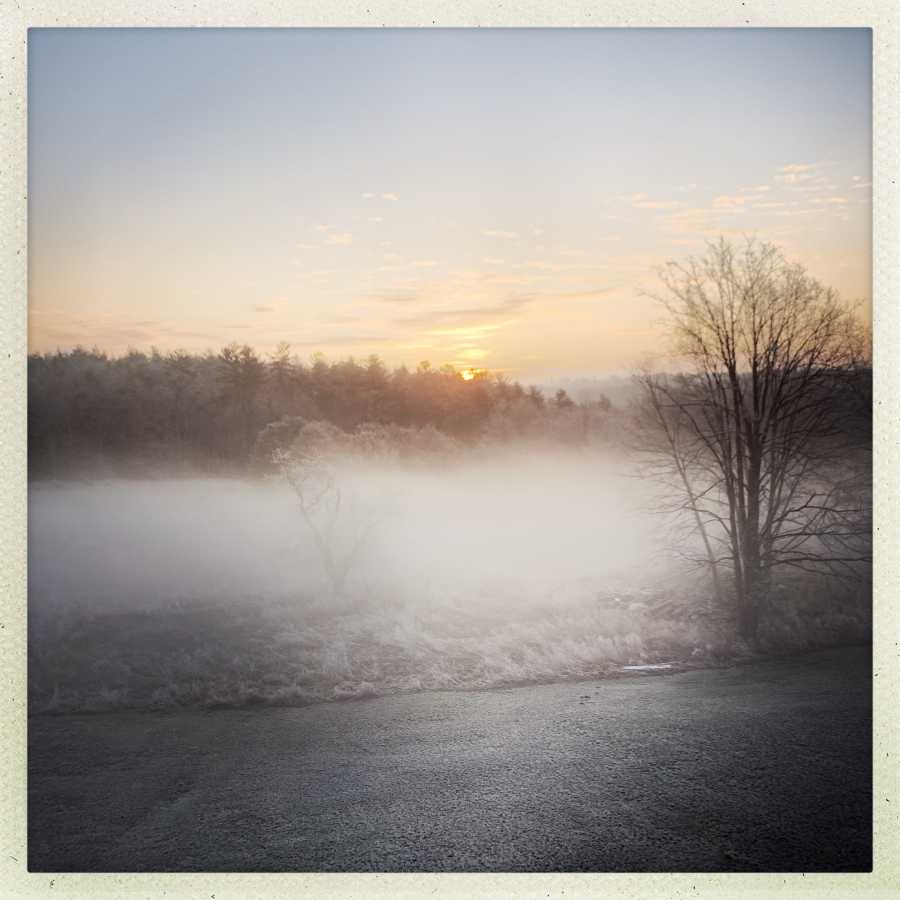I call this “frost fog” but that’s probably not the right name for it. It’s frost that melts off early as the sun rises, and becomes a cold, dense, low-lying fog.
Many mornings when I would fly from Baltimore to Chicago (airline hub to airline hub) my flights would take me over the mountains where I now live, and I’d see the Appalachian mountains with puddles of clouds in the valleys. I don’t understand why this happens; it’s obviously not just a question of altitude, it’s got to have something to do with winds and shelter and the presence of water. But it’s surprisingly beautiful, quite often.
I can throw my bedroom window open and this is what I see:


Sounds like it’s related to Tule Fog (https://en.m.wikipedia.org/wiki/Tule_fog). Not exactly the same, but close.
@sjdorst:
It does sound like it!
There’s a spot over on the far side of my yard where clouds form at dusk. It’s really cool. I’m not talking a little whispy stuff – these are serious clouds. I love my weather.
Could be either radiation (cooling of still air because of clear skies) or advection (mixing of cold air draining into the hollow with moist air already there). Many fogs are a mixture of the two. For a great example of a pure mixing fog demo:
https://pdfs.semanticscholar.org/71c0/557da07a6bd5a85c5a997b9ba1791c9af321.pdf
did you try going into the fog and try waving your arms about?
astringer@#3:
did you try going into the fog and try waving your arms about?
I spend most of my life in a fog waving my arms about; it never occurred to me to try doing it deliberately.
I can aprreciate the prettiness of the picture, but that kind of weather looks unpleasant.
Charly@#5:
I can aprreciate the prettiness of the picture, but that kind of weather looks unpleasant.
It’s bracing! If you put on a couple layers of padding, you can run about in it just fine, although the moist air will suck the heat right out of you.
Weather like that only gets to be called “bracing” if you’re out in it for under ten minutes. After that it’s just cold.
In Portland, Oregon there are tall hills to the immediate west of the Willamette River (which divides the city in two), but even on the east side the ground is significantly set above the river level.
Every once in a while there are morning fogs that rise out of the Willamette and cover the buildings on the east side far enough out that by the time individual hills rise up out of it, you can’t pick out any distinct human constructions. You’re in the middle of a city, but if you’re near the west bank of the Willamette looking east, you can’t see a single thing made by human hands. It’s … amazing. I still cherish memories of a few of those mornings.
============
OT: This reminded me of you – not just Damascus blades generally, but combined with those octagonal handles that I’ve seen you use, with a different colored cap from the rest of the handle. Of course, I don’t trust them at all the way I would trust your work, seeing as how they’re charging $80 for FOUR knives that are supposedly “hand-forged”. I wonder what the con is?
Also, don’t they realize that they could have charged 10x the price if they just painted the handles black and called them tactical?
German knows “Talnebel” valley fog and “Höhennebel”, height fog, while the latter is actually a very low hanging cloud. Talnebel happens when cool, humid air sinks to the ground and has no way to “escape”. On my commute I sometimes drive from “brilliant sunlight” to “who painted the windshield white” and back again a couple of times in 30 minutes.
Nasty when you’re looking forward to a walk in sunlight but then you get home and sunlight is just a rumour.
I think those were probably cloud inversions, which has something to do with air down in the valley being cooler than the air up higher.
Saad@#10:
I think those were probably cloud inversions, which has something to do with air down in the valley being cooler than the air up higher.
I think that’s right. It often (but not always) tracks water – I assume it’s thermal mass.